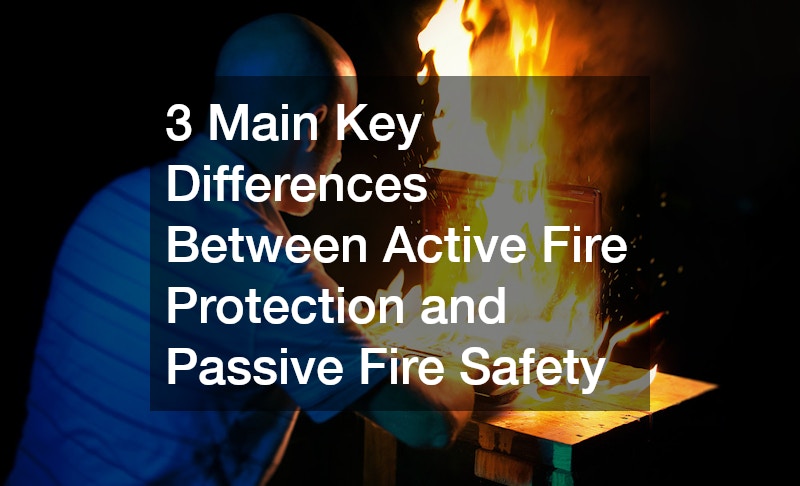Fire safety is a fundamental consideration in any building’s design, construction and ongoing management. Yet, many people are unclear about the distinct roles that different fire protection systems play. There are two primary categories: active fire protection and passive fire safety. Understanding how these systems differ is vital for making informed decisions about fire prevention, containment and response within a property.
While both systems aim to protect lives and minimise property damage, they function in very different ways. One is immediate and intervention-based, while the other is structural and preventative. Below are three key differences that separate these fire protection strategies and explain why a well-rounded approach requires both.
Response vs Resistance: The Core Purpose of Each System
The most fundamental difference between active fire protection and passive fire safety lies in how each system responds to fire. Active fire protection systems are designed to take action when a fire occurs. These systems detect, suppress or extinguish fires using manual or automatic methods. Examples include sprinkler systems, fire alarms, smoke detectors and fire extinguishers. Their role is to intervene as quickly as possible to control or eliminate the fire threat.
In contrast, passive safety is all about resistance . It focuses on the built-in fire-resistant features of a structure that help slow the spread of fire and smoke. These features include fire-rated walls, doors, ceilings and floors, along with sealing systems designed to prevent the passage of flames and hot gases. These structural elements don’t require human intervention or a trigger to activate—they are always working in the background, providing constant protection.
By resisting heat and flame, passive systems buy valuable time for occupants to evacuate safely and for emergency responders to arrive. They form the backbone of a building’s fire strategy and help ensure compliance with Australian building codes and safety standards.
Manual vs Built-In Technologies
Another significant difference lies in the physical operation and technology behind each system. Active fire protection relies heavily on mechanical or electronic systems, many of which require regular maintenance, testing and occasional manual input. For instance, fire alarms need to be calibrated, sprinklers require pressure tests and fire extinguishers must be checked for charge levels. These systems depend on electricity, sensors and sometimes human activation to perform effectively.
Passive safety systems, on the other hand, are embedded in the design and materials of the building itself. Fire-resistant walls, for example, are constructed using specialised gypsum board or concrete materials that naturally withstand high temperatures. Fire doors are fitted with intumescent seals that expand when heated to block gaps. These elements are part of the building’s construction and require little to no ongoing maintenance, though regular inspections are still recommended to ensure structural integrity and compliance.
Because passive systems are part of the architecture, they also contribute to the building’s energy efficiency and overall design cohesion. They remain in place for the life of the building, which makes them a cost-effective long-term fire safety solution.
Timing of Effectiveness: Immediate Action vs Long-Term Defence
The third key difference is the timing of when each system becomes effective. Active fire protection kicks in once a fire has already ignited. It is responsive, aiming to stop the fire in its tracks or reduce its intensity. This reactive nature makes it essential in any emergency, helping to save lives and minimise damage in real-time.
Conversely, passive fire safety plays a preventative and containment role. It does not wait for a fire to start; instead, it is constantly working to limit the fire’s ability to spread. These systems are especially critical in large buildings, multi-storey structures and facilities where evacuation times may be longer. By creating compartments and fire-resistant barriers, passive measures help to isolate fire to its point of origin, preventing it from engulfing the entire structure.
In high-risk environments, such as hospitals or manufacturing plants, this layered defence strategy is invaluable. It allows emergency teams to isolate threats more efficiently, reduces the chances of total structural failure and gives everyone inside the building more time to evacuate safely.
Why a Comprehensive Approach Matters
Relying solely on either active or passive measures can leave serious gaps in a building’s fire protection plan. Active fire protection is essential for controlling and extinguishing fires once they’ve started, but it can’t stop smoke from spreading or maintain the structural integrity of a building during a fire. Similarly, passive safety helps contain fires but cannot detect or extinguish them.
A comprehensive fire safety strategy should combine both systems to deliver the highest level of protection. Together, they form a layered defence that responds immediately and resists long-term threats. This integration is also a key requirement in meeting Australian building regulations and fire safety codes, which mandate a balance of detection, suppression and containment.
.





